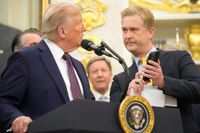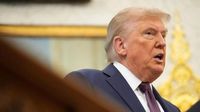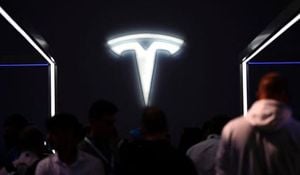On September 2, 2025, President Donald Trump found himself at the center of a digital-age controversy that, in many ways, encapsulates the confusion and spectacle of modern American politics. It all began with a viral video: a grainy clip showing what looked like a black trash bag and a long white object being tossed from an upstairs window of the White House. The footage, first posted by the popular Instagram account washingtonianprobs over the weekend, quickly ignited a flurry of speculation, jokes, and conspiracy theories across social media platforms.
During a press conference in the Oval Office, Fox News reporter Peter Doocy brought the matter directly to the president. "There’s a video that is circulating online now of the White House where a window is open to the residence upstairs, and somebody is throwing a big bag out of the window," Doocy asked, holding up his phone to show Trump the clip. The president, never one to shy away from the limelight—or controversy—offered an immediate and emphatic response. "No, that’s probably AI-generated," Trump replied. "Actually you can’t open the windows, you know why? They’re all heavily armored and bulletproof."
Trump doubled down, insisting, "So that’s a fake video? Well it’s gotta be, because I know every window up there. The last place I’d be doing it is that because there’s cameras all over the place right, including yours. No, but every window … they’re bulletproof. And number one, they’re sealed, and number two, each window weighs about 600 pounds, so you have to be pretty strong to open them up. No, that has to be—where was the window? Let me see it." He peered at Doocy’s phone, squinting at the footage, and mused aloud about the window’s location before reiterating, "Yeah those windows are sealed. Those windows are all sealed, you can’t open ‘em."
Trump’s insistence on the impossibility of the video’s authenticity was, on its face, a clear attempt to cast doubt on the footage. He even invoked the specter of artificial intelligence, a technology increasingly known for its ability to create convincing fake videos, or "deepfakes." "That’s probably AI-generated," Trump said, adding, "It’s got to be because I know every window up there. … Number one, they’re sealed, and number two, each window weighs about 600 pounds." He went on to lament the state of modern technology: "One of the problems we have with A.I., it’s both good and bad. If something happens, really bad, just blame A.I. But also they create things. You know, it works both ways. If something happens, it’s really bad, maybe I’ll have to just blame A.I."
But as reporters and the public soon learned, the truth was far more mundane—and the video was indeed real. The White House press office, in statements to several news outlets including Time and The Associated Press, confirmed that the video showed a contractor performing regular maintenance while the president was away. "It was a contractor who was doing regular maintenance while the President was gone," a White House official told Time. The president, for his part, was not at the White House during much of the weekend, instead spending time at his golf club in Virginia, according to multiple reports.
To further clarify the video’s authenticity, digital forensics expert Hany Farid of the University of California, Berkeley—who also serves as chief science officer at deepfake detection firm GetReal—reviewed the footage. Farid’s assessment was unequivocal. "We do not detect any digital watermarks that are sometimes inserted at the point of AI-generation. The shadows in the scene, including the shadow cast by the tossed bag, are all physically consistent," Farid explained. "The motion of the waving flags have none of the tell-tale signs that you often see in AI-generated videos. The overall structure of the White House appears to be consistent, including the flying of the American and POW/MIA flag."
Despite these expert assessments and the White House’s own confirmation, Trump continued to lean on the AI explanation, perhaps seizing on the public’s growing anxiety over digital misinformation. "It’s the kind of thing they do," he remarked. "And one of the problems we have with AI, it’s both good and bad. If something happens really bad, just blame AI. But also they create things, you know?" His comments struck a chord in a media environment increasingly beset by questions of authenticity and trust.
Adding a personal touch to his explanation, Trump recounted that First Lady Melania Trump had also complained about the White House’s famously impenetrable windows. "She said, ‘Love to have a little fresh air come in.’ But you can’t. They’re bulletproof," he said. "Number one, they’re sealed. And number two, each window weighs about 600 pounds. You have to be pretty strong to open them up." This detail echoed a similar complaint made by former First Lady Michelle Obama a decade earlier, who, in a 2015 appearance on "The Ellen DeGeneres Show," lamented, "The windows in our house don’t open."
Trump’s quick pivot to blaming AI for the video, even after his own staff had provided a plausible and non-nefarious explanation, drew criticism and sparked debate about the president’s relationship with truth and technology. As The New York Times noted, Trump has a history of blurring the line between fact and fiction, particularly when it suits his interests. He has previously reposted AI-generated fake videos and repeatedly made unfounded claims about the 2020 election results. In the context of the viral video, his response seemed to be as much about managing the narrative as it was about addressing the specific incident.
The episode also highlighted a broader societal challenge: in an era where AI-generated images and videos are increasingly convincing, distinguishing between reality and fabrication has become a daunting task for the public. Trump himself acknowledged the "scary" power of such technology, describing his own experience with AI-generated videos that appeared to show his life from childhood onward. "I see so many phony things," he said. "I saw something, as I was growing up from the time I was a baby till now, I said, ‘Who did that?’ It was A.I. generated. So it’s a little bit scary to be honest with you."
Yet, for all the talk of high-tech trickery and bulletproof windows, the most remarkable aspect of this story may be its ordinariness. The viral bag was not evidence of scandal, subterfuge, or secret plots. It was, according to the White House, just a maintenance contractor doing their job. But in a political climate primed for suspicion and spectacle, even the most mundane moments can become fodder for national debate—especially when the president himself is eager to cast doubt, and the tools of digital deception are never far from reach.
This incident, with its mix of real-world maintenance and digital-age misdirection, serves as a reminder of both the power and the peril of modern technology. The truth, it seems, can still be tossed out the window—sometimes literally, sometimes figuratively—but it has a way of landing in plain sight.





